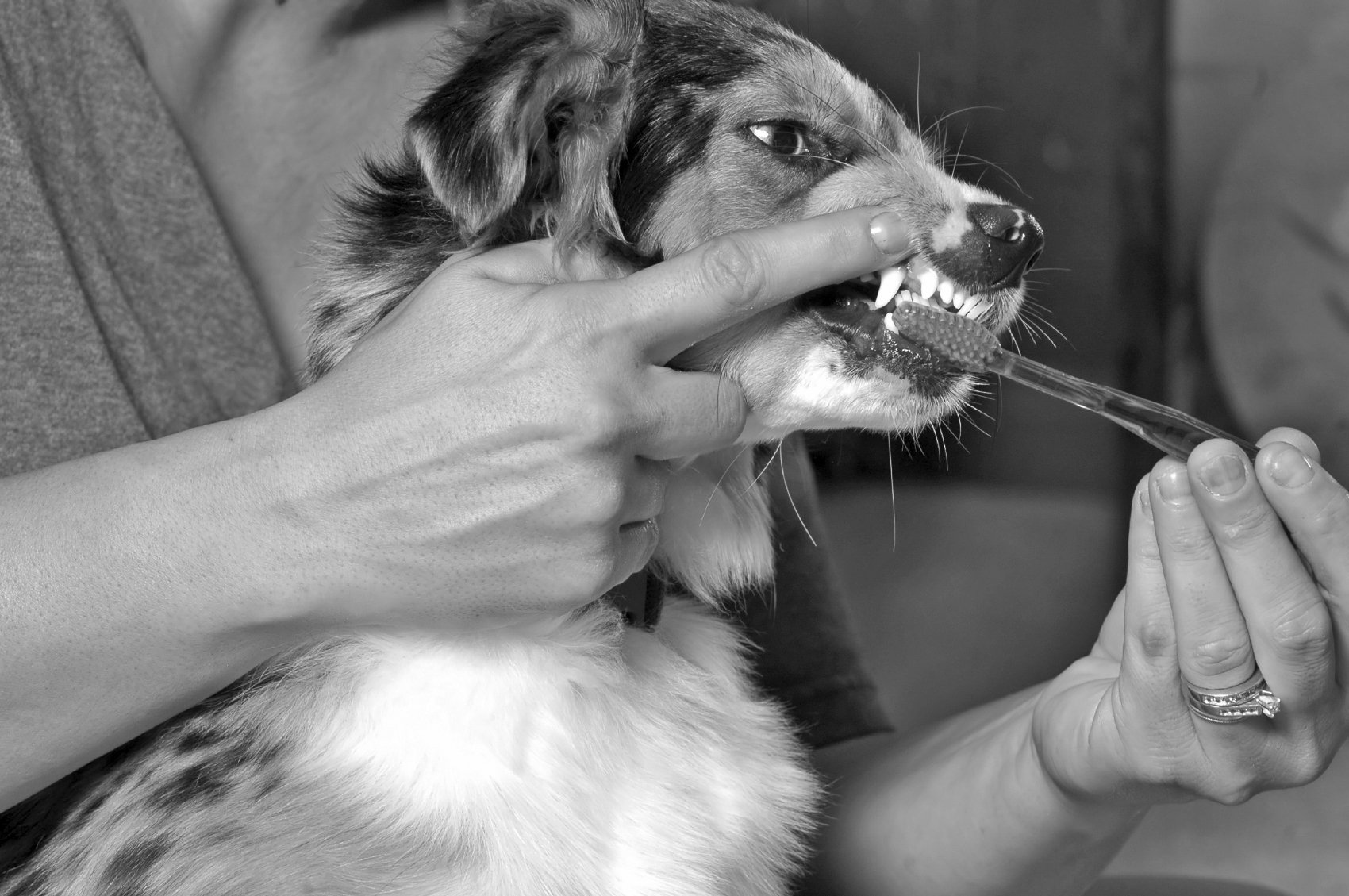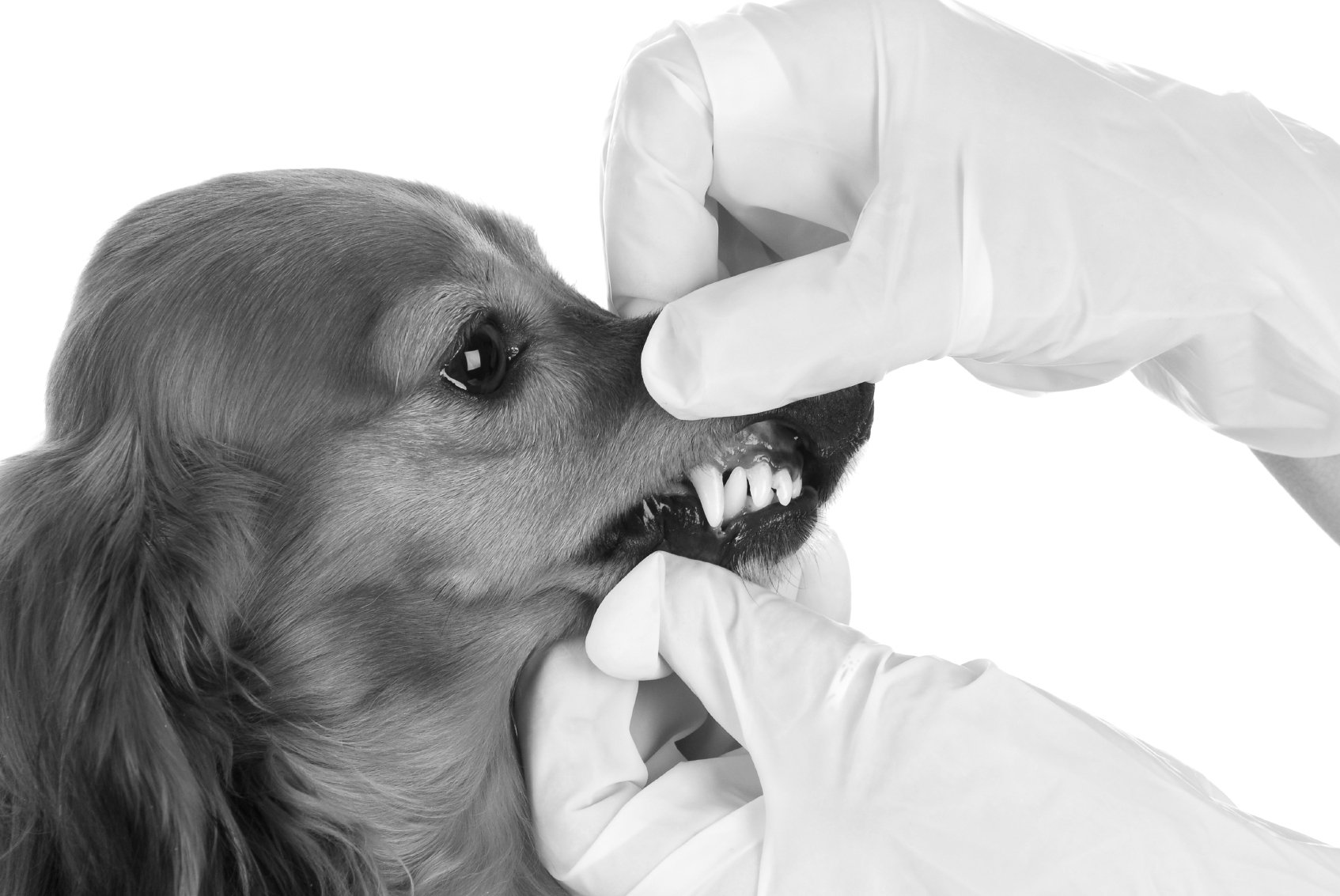[From Tufts September 2012 Issue]
Unfortunately, says Jean Joo, DVM, a veterinary dentist at Tufts, “a lot of the dogs we see, the owner doesn’t start brushing their teeth until something catastrophic has happened, perhaps the extraction of eight to 10 teeth. That’s when owners really get motivated.”
@ISTOCKPHOTO

Daily brushing makes all the difference, she says. “One little Scottish terrier I saw — I can’t remember how many teeth I had to extract from his mouth due to rampant dental disease. That was 16 months ago. Since then, the owner has been really diligent. I recently saw the dog for a check-up, and there’s now not a speck of tartar,” which is hardened plaque that harbors gum- and bone-eroding bacteria and can eventually lead to tooth loss. “If people brushed their dogs’ teeth from the time they were puppies” instead of waiting until a crisis, Dr. Joo comments, they wouldn’t have to start taking their pets for professional cleanings until later in life, and then, less often than otherwise, a significant point since a cleaning requires anesthesia (we haven’t yet seen a dog who will voluntarily sit still and “open wide”). And the dogs would be more likely to retain all their teeth and never suffer any dental pain, which turns some perfectly pleasant, docile dogs into snarling, even biting, animals. Dr. Joo speaks of one patient, a Poodle, who wouldn’t let anyone near him, not even to stroke him. But once she removed four teeth that were causing him unbearable discomfort (an all too common problem), he became pettable again, calm and at ease.
The reason to brush your dog’s teeth is not to stave off cavities. Dogs don’t get cavities very often, perhaps, at least in part, because they have fewer pits and fissures in their teeth to grind food. Those indentations are where food particles, and the cavity-causing bacteria that feed off them, accumulate.
Instead, you’re brushing your dog’s teeth to prevent gum disease, known in dental circles as periodontal disease. Gum covers the bone that anchors a tooth in place. If the gums are not kept clean, they recede. Then the bone under the gums recedes, no longer capable of keeping teeth stable.
Brushing every day also staves off complications from various conditions to which many dogs fall prey as they grow older. For instance, a dog with diabetes has weakened immune and circulatory systems. Compromised teeth with harmful bacteria that cause dental infections can, in turn, make the diabetes harder to control. The dog’s immune system becomes overwhelmed.
Congratulations, you’re now a dental hygienist
While in the best of all possible worlds, you’ve been brushing your dog’s teeth every single day since he first came to live with you, it’s never too late to start. “A lot of dogs are pretty head shy,” Dr. Joo says. “And they don’t want things in their mouth that they haven’t decided on putting there.” For that reason, she explains, I usually tell people to begin by petting their dog around the face and slowly working up to teeth brushing from there.”
The brush should be either a soft toothbrush for people that easily fits into the dog’s mouth, or one made for dogs that has a long handle or fits over the fingertip like a flexible thimble with bristles on the end. Even gauze wrapped around your finger will work.
Toothpaste is not necessary, but some canine toothpastes contain an enzymatic cleanser to help disrupt the filmy layer of plaque that clings to teeth and gums and must be dislodged to help keep offending bacteria within it from finding a home in your dog’s mouth. If you decide to use a toothpaste (never use one for people as a dog will swallow the fluoride and foam, both of which are bad for him), look for ingredients with the suffix “ase,” which is chemistry shorthand for “enzyme.” The most common ones are lactoperoxidase and glucose oxidase.
The most popular flavor tends to be poultry, although there’s also seafood, peanut butter, vanilla mint, and malt. Dogs are not typically fans of mint. Smelling fresh is not high on their list.
Dog breath is not a sign of dental disease, incidentally; it’s just a sign of dog. But dog breath in combination with loose teeth and pus is a sign of dental disease. It means the bone anchoring the tooth in place is eroding. If the problem gets out of hand, the jaw can weaken so much that blood vessels beneath the bone start to bleed, allowing a pathway for bacteria to enter the bloodstream. (Some veterinary researchers believe this can potentially damage the heart.)
During brushing, try to angle the toothbrush where the teeth and gums meet. A lot of people focus on the white part, or enamel, which is important, but food has a way of sliding off the enamel on its own. It’s the tooth/gum juncture that’s tricky, and where so much of dental disease takes place.
Make sure to get the back teeth, which are a dog’s main chewing teeth and therefore the ones on which dental disease often occurs. Focus on the outside of the teeth, not just at the back but all around. It will make brushing easier. But, more important, you will get more bang for your brushing. The insides of a dog’s teeth have more contact with saliva, which has its own plaque-attacking chemicals.
Brush once a day, every single day. Some dogs come to love the procedure. The Labrador Retrievers belonging to Dr. Alicia Karas, Director of our Pain Consultation & Referral Service, make a game of it, not letting her leave the bathroom until she gives them their treat after brushing — a few morsels of a prescription-only diet that mechanically scrapes gunk from dogs’ teeth as they chew on it.
Dr. Joo points out that as much as some dogs come to love having their teeth brushed, others never cotton to it. And “if your dog really, really hates it,” she says, “don’t do it. It’s more important to have a good relationship with your pet and allow it a good-quality life. You don’t want a dog who runs away from you every time you go near him because he hates the thought of you getting near his mouth.”

Partner with your veterinarian
While most of your dog‘s oral hygiene takes place by your loving hand at home, once the dog reaches age five, talk to your veterinarian about whether it’s time to start a once-a-year schedule for professional cleanings. Only your dog’s doctor can get at tartar that accumulates under the gum line.
Cleaning or not, your vet should spend part of the annual exam looking at all the soft tissues of the dog’s oral cavity — cheeks, tonsils, tongue, and so on — to see if there’s any evidence of tumors, which can sometimes be malignant. The doctor should also check for missing or broken teeth. They’re important to spot because they can abscess, that is, form pus-filled cavities that can make an infection go from bad to worse. Finally, the vet should check for gum recession.
Note that veterinary dentistry is a relatively new entry to the field of veterinary specialties, having made it into the mainstream only about a decade ago. Your primary care vet should handle routine care, but if your dog needs more dental treatment than she or he can provide, you may want to check out the American Veterinary Dental College (avdc.org) for a board-certified diplomate in veterinary dental medicine in your area. Short of board certification, dental continuing education programs can give practitioners a bit of an edge — maybe your vet has even been through one.





